Do you love traditional dances? Indonesia has many traditional dances from many regions, including traditional dances from Central Java which has so much cultural heritage in Indonesia. Traditional dance from Central Java is commonly influenced by sacred traditional custom culture in Central Java is one of the largest ethnic groups in Indonesia.
The dance even contains some historical story that is popular among Indonesian fable. Traditional dance from Central Java commonly performs for specific events such as welcoming guests, celebrating Indonesian wedding traditions, and religious customs and cultural ceremonies.
If you are wondering what kind of traditional dance is from Central Java, here we have some of them on the list below. Let’s check them out!
1. Gambyong
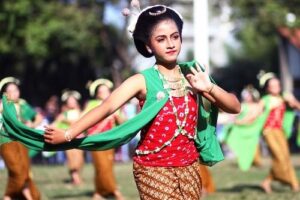
Gambyong is one of the traditional dances from Central Java that becomes of the cities with the largest population in Indonesia. Gambyong is a traditional dance that contains three parts which are well-known as Maju Beksan, Beksan, and Mundur Beksan.
Gambyong is a kind of traditional dance that used to be performed for farming rituals to celebrate the farm and ask gratitude for the next successful farming.
Later on, Gambyong becomes a traditional dance that performs to welcome guests in a kingdom family which is different from some of the most isolated tribes in Indonesia. As time goes by, the Mangkunegaran Kingdom allowed common people to watch the Gambyong performance.
2. Golek
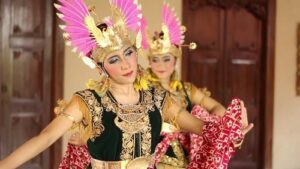
Golek is one of the traditional dances from Central Java that originally come from Yogyakarta but spreads well in Surakarta. The dance represents the young girl that tries to put some makeup on her face to look more beautiful. Golek is one of the traditional dances in Yogyakarta that commonly perform for welcoming guests.
It needs more than five dancers, but commonly not more than eight dancers to perform. For some specific purposes, Golek also can be performed by single dancers, but it is pretty rare to see a single performance of a Golek dance.
3. Bedhaya Ketawang
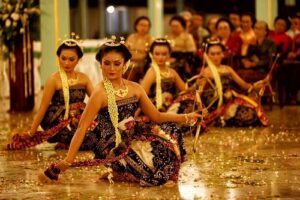
Bedhaya Ketawang is one of the traditional dances from Central Java that comes from Surakarta. This kind of traditional dance only performs during Sultan’s coronation day and every anniversary to remember Sultan’s coronation day. Bedhaya Ketawang is well-known as the sacred dance that contains most religions and myths at the same time.
The dancers need to follow a specific ritual before being allowed to perform this dance. Locals believe Bedhaya Ketawang should be performed with an odd number of dancers such as nine. During the dance, they believe that the magic of Nyai Roro Kidul would participate in the dance.
4. Serimpi
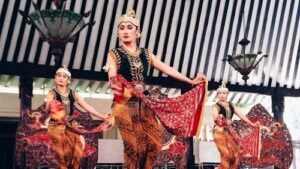
Serimpi is one of the traditional dances from Central Java that originally comes from Surakarta dan Yogyakarta the most popular kingdom in Central Java. This kind of dance was used to perform against struggle the against colonialism. Serimpi contains heroic movements which start with slower and faster movements until the end.
Different from typical traditional dance from Central Java that commonly come in slower movement. Serimpi dance movements contain three parts of dance complete with a traditional story behind them, such as Maju Gawang, Pokok, and Mundur Gawang. Not only represent the struggle against colonialism but also a triangle love story.
5. Bondan
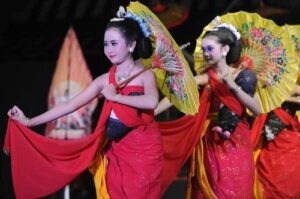
Bondan is one of the traditional dances from Central Java that originally comes from Surakarta. This kind of dance is used to perform by young villagers that perform in front of the king. The Bondan dance’s performance is commonly followed by Javanese traditional music that calls as Gending Jawa.
There are three different kinds of Bondan dances, such as Bondan Cindogo, Bondan Mardsiwi, and Bondan Pegunungan. Overall, the Bondan dance has a unique story that represents the love of a mother for her lovely daughter.
6. Beksan Wireng
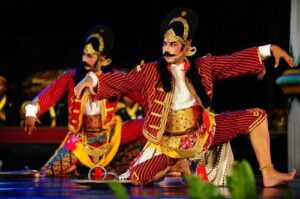
Beksan Wireng is one of the traditional dances from Central Java that originally comes from Surakarta. This kind of traditional dance was found around the 11th century and written in Serat Centini Sanskrit. Beksan Wireng is one of the oldest traditional dance from Central Java that still exist up until now.
The dance used to create for the son of the king so that he would love the country and be willing to learn how to be a soldier. Beksan Wireng commonly performs by four dancers-man, which represents a manly power. The performance would follow the traditional musical instrument of Gendung Sampak, Gendhing Ladrang, and Gendhing Ketawang.
7. Gambir Anom

Gambir Anom is one of the traditional dances from Central Java that comes from Surakarta. This kind of conventional dance has already existed since the Islamic Mataram kingdom era. Gambir Anom represents the Arjuna, one of the popular characters on traditional puppets of Ramayana who falling love for the first time.
The dance contains a slower movement to describe the beauty of falling in love. Gambir Anom is commonly performed by a single dancer complete with the traditional costume that represents the Ramayana story for the dance.
8. Dolalak
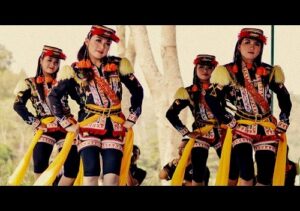
Dolalak is one of the traditional dances from Central Java that comes originally from Purworejo. This kind of dance was used to create to mocking colonialism before Indonesia declared independence. Dolalak dance would be performed by more than five dancers wearing unique costumes that represent the colonialist uniform, such as from the Dutch and France.
Dolalak dance commonly performs with loud traditional music such as Kentrung, Rebana, Gendang, and Kecer. This kind of traditional dance commonly performs during the Independence Day celebration.
After knowing some of the traditional dances from Central Java above, you will be more knowledgeable about the variety of traditional dances in Indonesia. Have you ever seen those dance performances? Tell us which one that becomes your favorite so far.